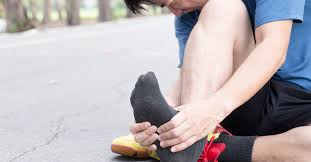Few people are familiar with plantar fasciitis or how painful it is. Peyton Manning experienced it in 2015 following a game-related injury.
Although it is a condition that regularly affects professional athletes, it affects average individuals much more frequently than you may imagine. To discover more about a plantar fascial tear, continue reading.
What is the plantar fascia?
According to a professor of family medicine at the University of Minnesota, the plantar fascia is a strong band of connective tissue that crosses the longitudinal axis of our foot between the heel bone as well as the base of the proximal phalanges.
The tissue creates the tension part of the longitudinal arch’s tension-compression structure and prevents the arch from collapsing under pressure. When walking or running, it also functions as a “windlass” to enhance the longitudinal foot-to-toe alignment. In other words, it maintains the functionality of your feet.
So, running definitely depends on your plantar fascia. When you run, your foot pronates with each step to lessen the impact. This flattens the arch of your foot and puts tension on your plantar fascia.
What can cause heel pain in the morning?
People suffering from plantar fasciitis tear may often complain of certain heel pain, and usually, it is reported that it gets worse in the morning or after you sit or simply rest for a while.
When you first apply load to a plantar fascia, scar tissue may microtear, which is thought to be the cause of the extreme discomfort you experience when you wake up from rest.
When at rest, your plantar fascial ligament will go through a process known as fibrosis (or the creation of scar tissue. The scar tissue gets torn when a person with a healed plantar fascia gets up from lying down, which produces pain in the first few steps.
Often the tearing may occur at the origin of yourtorn plantar fascia just under the heel bone. After 8 to 10 steps, the tearing eventually stops, and the discomfort subsides.
The discomfort will typically recur if the person stands and walks for extended time during the day. In conclusion, tiny breaking of the scar tissue that grows to mend the plantar fascia is what causes heel pain in the morning.
Plantar fasciitis versus partial plantar tear
Plantar fasciitis is characterized by tiny tears in the plantar fascia. One in ten people will experience it at some point in their lifetimes, making it one of the most frequent running injuries.
Inflammation of the plantar fascia known as plantar fasciitis can cause discomfort or edema. It is a cumulative problem brought on by too much stress or tension on your plantar fascia.
A partial plantar fascia tear, on the other hand, results in a rip in the fascia. It is a rather rare ailment, and it is typically brought on by a single incidence, such as when a runner takes a step that causes a strong push to occur in the center of the foot.
The runner will probably feel a rip or tug on the bottom of their foot, and they will realize something is wrong right away.
What are the symptoms?
The key distinction between plantar fasciitis and a plantar tear is that the tear will feel much more severe at the time.
- A jump or sprint-related episode of acute foot loading that causes a tearing feeling in the foot and also subsequent heel or arch discomfort is the typical presentation of a certain partial plantar fascia tear.
- Other signs and symptoms tend to involve
- Difficulty walking
- Excruciating pain in the arch or heel while at rest or walking
- A painful lump inside the heel or arch or with certain swelling or bruising,
- Hearing or feeling a pop or sometimes tearing in the foot
- The arch collapsing
- Pain when the toes seem to be bent upward
- Hearing or feeling a popping
- Tearing in the foot.
How can you treat it?
Since a plantar fascia partial tear typically heals successfully without surgery and the possibility of improvement may outweigh the danger of scarring, this injury is not typically seen to be one that may be surgically repaired.
Treatment depends exactly on what is going on with the plantar fascia of the patient.

